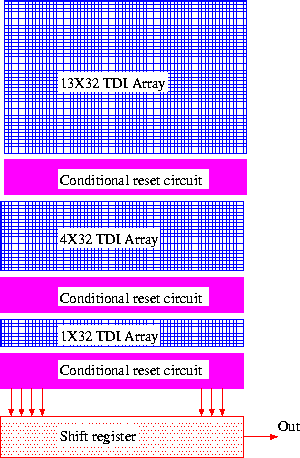The ![]() pixel-level adaptive sensitivity technology enables image sensors to
acquire wide dynamic range scenes without loss of detail, by adjusting
the sensitivity of individual pixels, according to the intensity of
light incident upon it. An adaptive sensitivity time delay and
integrate (TDI) CCD sensor has been designed by the VLSI Group in
Technion [Chen and Ginosar 96].
pixel-level adaptive sensitivity technology enables image sensors to
acquire wide dynamic range scenes without loss of detail, by adjusting
the sensitivity of individual pixels, according to the intensity of
light incident upon it. An adaptive sensitivity time delay and
integrate (TDI) CCD sensor has been designed by the VLSI Group in
Technion [Chen and Ginosar 96].
The sensor comprises 18 TDI integration stages, with a horizontal resolution of 32 pixels. The level of charge integrated in each pixel is monitored as the pixel charge packet progresses across the TDI array. If the charge accumulates to above a certain threshold level, the pixel is discharged. The architecture of the sensor is shown in Figure 6.2. The ``conditional'' reset mechanisms are inserted after the thirteenth and seventeenth stages. Thus, each individual pixel may be integrated over 1, 5, or all 18 stages. Since in TDI scanning there is no concept of ``frames'' and each pixel is imaged only once, the intensity sensing and the decision on how long to integrate must be performed ``on the fly''. But, while in regular linear sensors the perpendicular fill factor is unlimited and complex control circuits may be placed next to the detectors, the two dimensional nature of TDI sensors presents much more demanding architectural and circuit challenges.
The chip has been fabricated in a 2 ![]() m CMOS/CCD process, in a TINY
chip (2.22mm
m CMOS/CCD process, in a TINY
chip (2.22mm ![]() 2.22mm).
2.22mm).

Figure 6.2: Architecture of Technion's TDI sensor.